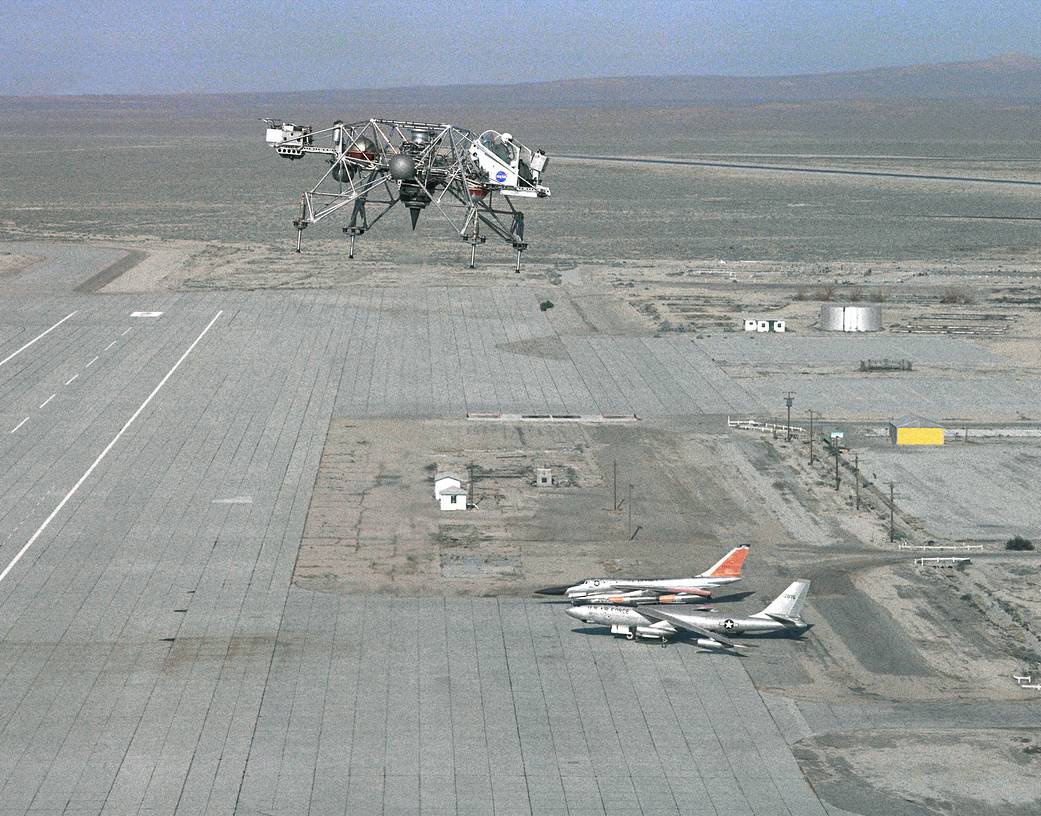
ECN-688
In this 1965 NASA Flight Research Center photograph, the Lunar Landing Research Vehicle (LLRV) is shown at near maximum altitude over the south base at Edwards Air Force Base.
When Apollo planning was underway in 1960, NASA was looking for a simulator to profile the descent to the moon’s surface. Three concepts surfaced: an electronic simulator, a tethered device, and the ambitious NASA Flight Research Center (FRC) contribution, a free-flying vehicle. All three became serious projects, but eventually the NASA FRC Landing Research Vehicle (LLRV) became the most significant one. Hubert M. Drake is credited with originating the idea, while Donald Bellman and Gene Matranga were senior engineers on the project, with Bellman the project manager. Simultaneously, and independently, Bell Aerosystems Company, Buffalo, NY, a company with experience in vertical takeoff and landing (VTOL) aircraft, had conceived a similar free-flying simulator and proposed their concept to NASA Headquarters. NASA Headquarters put FRC and Bell together to collaborate. The challenge was to allow a pilot to make a vertical landing on Earth in a simulated moon environment, one sixth of the Earth’s gravity and with totally transparent aerodynamic forces in a “free flight” vehicle with no tether forces acting on it.
Built of tubular aluminum like a giant four-legged bedstead, the vehicle was to simulate a lunar landing profile from around 1500 feet to the moon’s surface. To do this, the LLRV had a General Electric CF-700-2V turbofan engine mounted vertically in gimbals, with 4200 pounds of thrust. The engine, using JP-4 fuel, got the vehicle up to the test altitude and was then throttled back to support five-sixths of the vehicle’s weight, simulating the reduced gravity of the moon. Two hydrogen-peroxide lift rockets with thrust that could be varied from 100 to 500 pounds handled the LLRV’s rate of descent and horizontal translations. Sixteen smaller hydrogen-peroxide rockets, mounted in pairs, gave the pilot control in pitch, yaw, and roll. On the LLRV, in case of jet engine failure, six 500-pounds-of thrust rockets could be used by the pilot to carefully apply lift thrust during the rapid descent to achieve a controllable landing. The pilot’s platform extended forward between two legs while an electronics platform, similarly located, extended rearward. The pilot had a zero-zero ejection seat that would then lift him away to safety. Weight and balance design constraints were among the most challenging to meet for all phases of the program (design, development, operations).
The two LLRVs were shipped disassembled from Bell to the FRC in April 1964, with program emphasis placed on vehicle No. 1. The scene then shifted to the old South Base area of Edwards Air Force Base. On the day of the first flight, Oct. 30, 1964, NASA research pilot Joe Walker flew it three times for a total of just under 60 seconds, to a peak altitude of approximately 10 feet. By mid-1966 the NASA Flight Research Center had accumulated enough data from the LLRV flight program to give Bell a contract to deliver three Lunar Landing Training Vehicles (LLTVs) at a cost of $2.5 million each. As 1966 ended, the LLRV #1 had flown 198 flights, and the LLRV #2 was being assembled, instrumented, and cockpit modifications made at the South Base. The first flight of the #2 LLRV in early January 1967 was quickly followed by five more. In December 1966 vehicle #1 was shipped to Houston, followed by #2 in mid-January 1967. When FRC’s LLRVs arrived at Houston they joined the first of the LLTVs to eventually make up the five-vehicle training and simulator fleet. All five vehicles were relied on for simulation and training of moon landings.May 11, 1965NASA Photo › Read LLRV Project Description

























